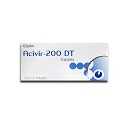Erlonat (Erlotinib)
Courier service EMS
Other transport services
Air India Post International
Payment in the bank on the invoice
WestrUnion
MoneyGram
Definition:
Erlotinib, generic for the trade name of Erlonat
Erlonat is the prescription medicine; it is prescribed for the patient only under the guidance of medical oncologist
Erlonat is comes under the class of “Tyrosine kinase inhibitor”
Tyrosine kinase is the one type of protein, which is essential for the cell growth
Erlonat involves in blockade of signals within the cancer cells
When Erlotinib (Erlonat) used
Erlonat is mainly used in the treatment of;
Advanced or metastatic non-small cell lung cancer
Main key points:
Erlonat is involved as first line treatment
Erlonat is also considered as maintenance therapy, patient those who are withstand after four chemotherapy cycles
Erlonat is used in the therapy for the patients whose cancer relapses after chemotherapy
Erlonat (Erlotinib) is also indicated for the treatment of advanced pancreatic cancer, by concomitant with Gemcitabine.
Erlonat mechanism;
Erlotinib, it works by exhibiting tyrosine kinase inhibitor activity.
Epidermal growth factor receptor (EGFR) is present on the surface of the cancer cells and in normal cells.
Cancer cells transmits signals through these receptors, which is essential for cell survival
Erlotinib prohibits kinase activity of EGFR and preventing the autophosphorylation of kinase residues related to receptor.
This inhibition of signal transduction causes cell death
ADME properties
Absorption:
The absorption of drug Erlotinib occurs after oral administration with the range of 60%
The bioavailability of drug is increased while taking with food to 100%
The peak plasma concentration of Erlotinib occur 4 hours after dosing
Distribution:
The apparent volume of distribution occurs at 232L
Nearly 98% of drug highly bound to the human plasma protein like albumin and alpha 1 acid glycoprotein
Metabolism:
Mostly the metabolism of the drug occurs in the liver. Metabolism undergone by using various cytochrome isoenzymes CYP3A4
Elimination:
About 91% of drug eliminated through feces and remaining will be excreted through urine
The median half-life period of the Erlotinib is occurs around 36.2 hours
Dosage and administration:
Non-small cell lung cancer:
The recommended dose of Erlonat is 150mg PO qDay 1 hr before or 2 hours after meals
Erlonat should be administered on an empty stomach
Limitations:
Erlonat not used in combination with platinum-based compounds
Safety and efficacy has not been established
Pancreatic cancer:
The prescribed dose is 150mg PO qDay with gemcitabine
Ant acids should not concomitant with Erlonat
Take Erlonat 10 hours after or 2 hours before administration of antacids
In pediatrics:
The safety and efficacy of the drug Erlotinib has not been established
Tablet Erlonat causes side effeects
>10%
Rashes, anorexia, diarrhea, fatigue, nausea, infection, vomiting, dyspnea, stomatitis, cough, Pruritus, conjunctivitis, dry skin, keratoconjunctivitis sicca, abdominal pain
1-10%
Elevation of LFT
Acne, paronychia,
Weight loss,
Pneumonitis pulmonary infiltrate,
Pulmonary fibrosis
<1%
Interstitial lung disease
Post marketing reports:
Musculoskeletal and connective tissue disorders: myopathy, rhabdomyolysis
Eye: ocular inflammation including uveitis
Erlonat interacts with
Co administration of Erlonat with strong CYP3A4 inhibitors or combined with CYP3A4 & CYP1A2 leads to increase Erlotinib exposure
CYP3A4 inhibitors like; boceprevir, clarithromycin, conivaptan, indinavir, itraconazole, ketoconazole, posaconazole, ritonavir, grapefruit
CYP3A4 & CYP1A2 inhibitors: ciprofloxacin
Cigarette smoking will decrease the Erlotinib exposure
While combining with coumarin derived anti-coagulants monitors the bleeding reactions and prothrombin time because it may cause elevation of bleeding
Precaution
If taking Erlonat, caution should be taken in the condition of;
Interstitial lung disease
Renal failure
Hepatotoxicity
Gastrointestinal perforation
Bullous and exfoliative skin disorders
Cerebrovascular accident
Ocular disorders
Hemorrhage
Embryo fetal toxicity
Contraindicated to
Pregnancy and women who become pregnant
Breast feeding
Hypersensitivity reaction
Pregnancy and lactation:
Pregnancy category: D
Erlonat should not be used in pregnancy period and lactation
Storage and handling:
The storage of Erlonat tablets container should be kept at 25oC (77oF); excursion between 15oC to 30oC
Container should be kept away from moisture, heat and light
Missed dose:
In case of missed dose, the patient should be advice by taking missed tablet within the period of next dose; otherwise the dose will be skipped and follow the regular dosing schedule
Do not double the dose
- Trade name Erlonat
- Substance Erlotinib 150mg
- Manufacturer Natco Pharma Limited
- Packaging 30 tablets
- Country of origin India
-
Convenient deliveryWe deliver to all countries of the World *. We cooperate only with trusted cargo carriers.
-
CONTROL AND INSPECTIONItem is checked before shipping! All the medicines are delivered directly from the manufacturer and sent from India to the client's address.
-
CHOOSE USWe provide the best price, including insurance against loss through the fault of the carrier. Our company cooperates directly with the largest manufacturers of medicines in India.
-
Promotions and DiscountsWe offer a flexible system of discounts for our customers and fixed discounts for current offers. Regular customers receive a discount of up to 10% of the amount of orders, as well as a remuneration system for referring customers via a referral link.
Запазете любимите си елементи към отметки
Това няма да загуби желаната опция!










